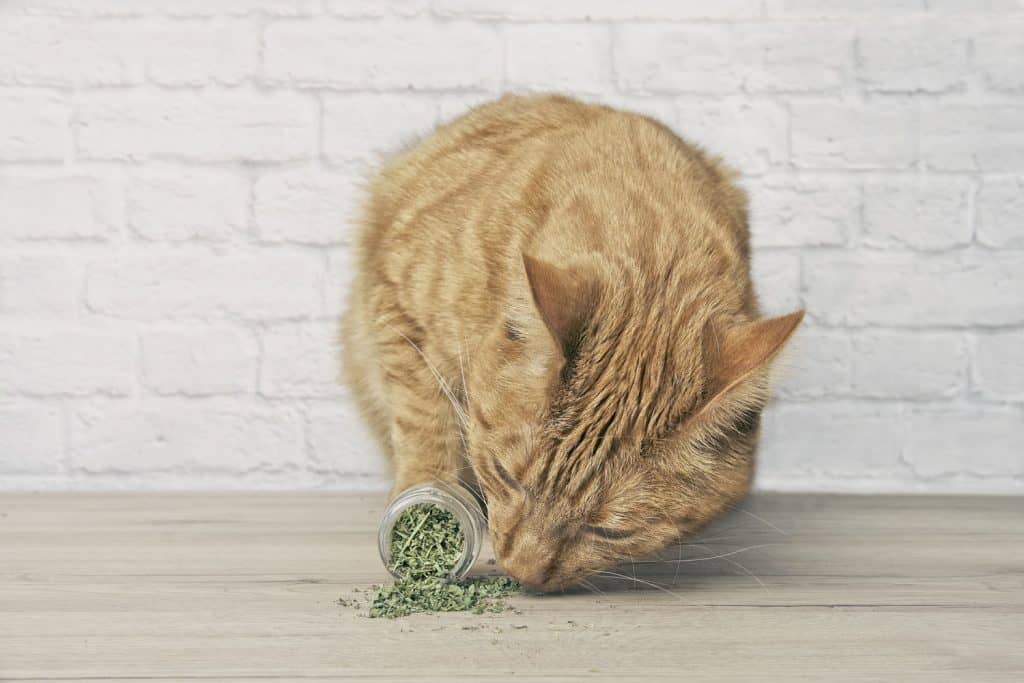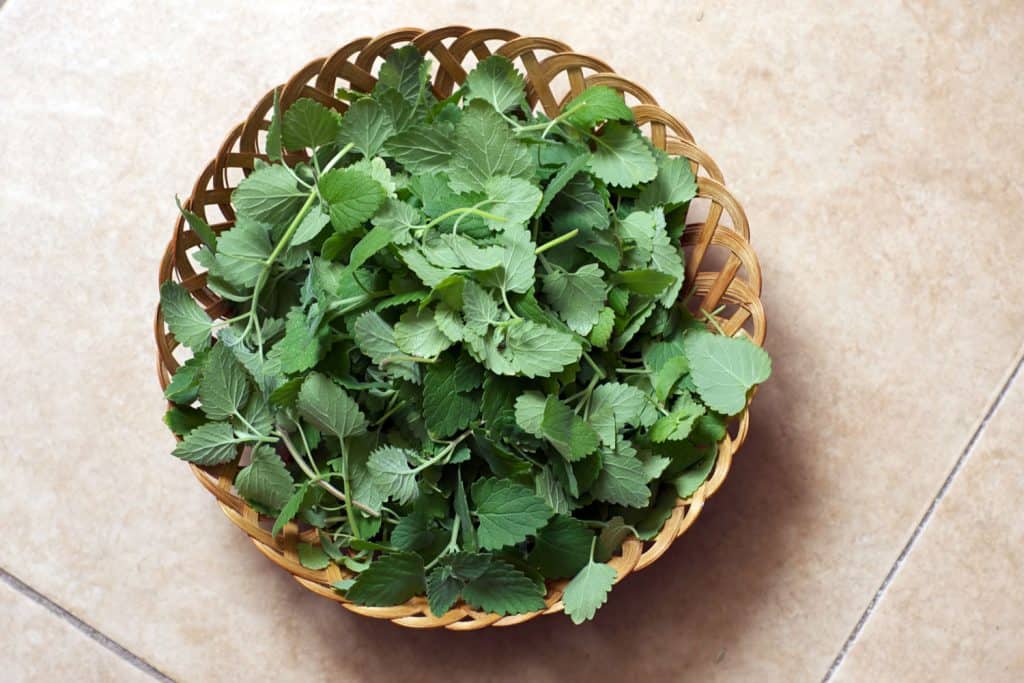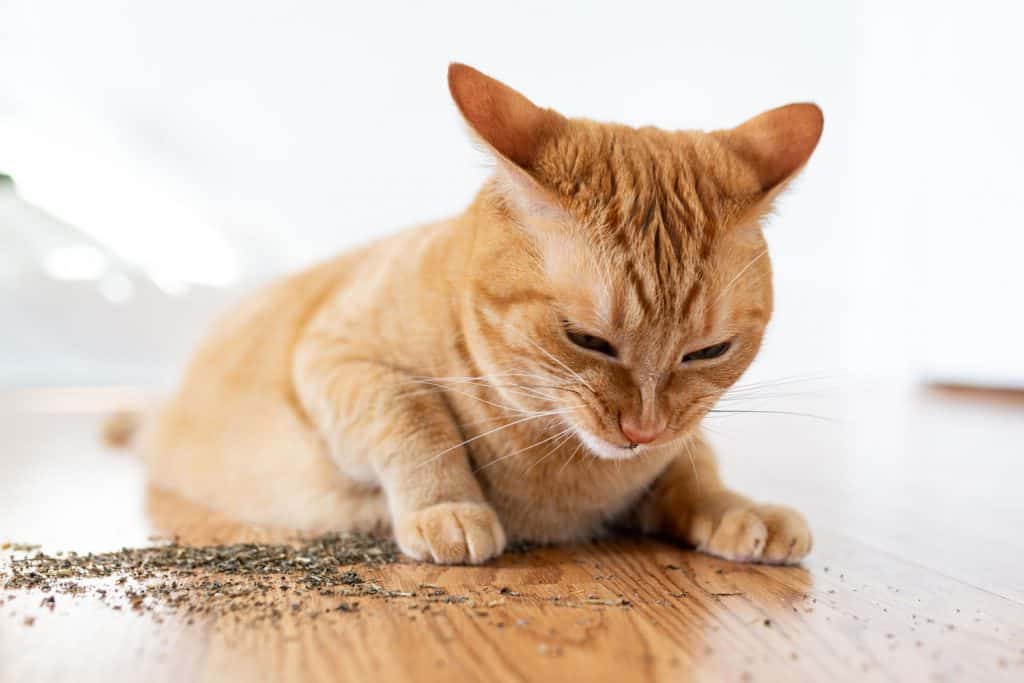Ever found your kitty friend nonchalant about the commonly adored catnip? Are you puzzled about what to offer instead to keep them engaged? This guide will give you catnip alternatives to consider for your cat.
Discover why some of our whiskered companions don't bat an eye at catnip and provide alternatives that can evoke the same feline joy.
We have expert advice, and a list of catnip substitutes, and will walk you through the benefits of each.
We will also provide a sneak peek into creating your homemade catnip and address some surprising questions about everyday items that might or might not serve as catnip replacements.
Expert-Approved Catnip Alternatives
Some cats aren’t fond of the scent of catnip (Nepeta cataria). A feline that’s relatively immune to the allure of catnip can be more challenging to train than average. So we asked the experts for some catnip alternatives.
Other than catnip, cats can also find the following items quite appealing:
- Silver Vine (Actinidia polygama)
- Tatarian Honeysuckle (Lonicera tatarica)
- Valerian Root (Valeriana officinalis)
Take note that the applications of these catnip alternatives can be different to promote optimal benefits. Keep reading to learn more about these catnip substitutes. Also, we’ll tackle other pieces of information about catnip, such as the steps to make homemade catnip and what to do if your cat isn’t fond of the particular plant.

What To Substitute For Catnip
Many cats find nepetalactone, the active chemical in catnip, irresistible.
However, some kitties don’t mind the scent of the chemical, leaving catnip toys and other objects infused with the plant to be nothing more than ordinary objects.
With that said, here are three alternatives to catnip that you can try for your household feline:
1. Silver Vine (Actinidia polygama)
Also known as the cat plant, silver vine is a plant native to China and Japan. It can grow to a maximum height of 6 feet and has distinctly beautiful-looking white flowers.
This particular plant carries many chemical compounds related to nepetalactone. Scientists even found that 80% of the participating cats in an experiment reacted positively to silver vine.
Furthermore, 75% of the tested cats were resistant to catnip but reacted positively to the cat plant.
The efficacy of the silver vine application in cats depends on which part of the plant you offer to your pet. The stem, leaves, and normal fruit tend to have less active compounds than the fruit galls.
You can make your cat play with silver vine sticks instead of catnip toys. But make sure to monitor your cat’s activity with silver vine. Accidental ingestion can lead to slight health concerns, such as coughing, drooling, and excessive meowing.
Limit your cat’s activity with silver vine just as you would when you’re regulating catnip to avoid the risks of contracting adverse effects.
Check out the ELOPAW silver vine cat sticks on Amazon.
2. Tatarian Honeysuckle (Lonicera tatarica)
Tatarian honeysuckle is a dense shrub. It's rich in twigs with small red, pink, and white flowers. Like the silver vine, Tatarian honeysuckle has an active chemical that produces a similar effect to catnip in cats.
Scientists found that compared to catnip, cats exhibit a similar unhindered playful behavior when exposed to Tatarian honeysuckle. However, at the time of writing, the overall effects of this plant on felines demand more research from scientific communities.
Still, cats don’t seem to contract significant adverse effects from the smell of Tatarian honeysuckle. Many kitties would react to this plant by sniffing, hugging, and rubbing it on their cheeks and chin.
Similarly use Tatarian honeysuckle to fresh or dry catnip by spreading the plant’s chips on certain items. For example, you can spread a small amount of Tatarian honeysuckle on your cat’s scratching post.
Click Here To See This SKE Tartarian Honeysuckle Blend
3. Valerian Root (Valeriana officinalis)
Valerian root is a plant with active compounds that help humans relax and sleep. It can help induce much-needed rest in folks suffering from insomnia, anxiety, and general restlessness.
As for cats, valerian root has the opposite effect since the plant will turn your household pet into a ball of energy.
Unlike catnip, valerian root has actinidine as its active chemical. This stimulant can make some cats start becoming excited while rolling around the moment they sniff the compound.
Still, take note that some cats that are immune to the allure of catnip may also be resistant to the charms of valerian root.
You can give your cat a valerian root cat toy to try and entertain them. But always keep in mind that valerian root in cat toys isn’t the same as giving your pet supplements with this herb.
The valerian root in human supplements can contain larger quantities of the plant, which might be harmful to your pet's well-being.
Click Here To See Valerian Root Catnip Alternative

How To Make Homemade Catnip
Catnip is a reasonably easy plant to grow. This heart-shaped foliage is also inexpensive, allowing pet owners to cultivate it while staying on a relatively tight budget.
The steps to growing homemade catnip are as follows:
- Soak a packet of catnip seeds in water overnight.
- Sow the seeds in cell packs or flats and press them into healthy soil. Lightly cover the small plantation to keep the seeds healthy at 60 degrees Fahrenheit (15.56 degrees Celsius). Avoid growing catnip seeds in summer or winter as it can be more difficult than average to keep them alive at their early stages.
- Once you see leaves starting to sprout, transfer the seeds to different pots. Make sure that the seeds have a 12 to 18-inch clearance from the edge of their containers to allow optimal growth.
- Place the pots under direct or partial sunlight. Additionally, catnip tends to grow the best with only average water while staying in well-drained soil.
- You can cut the leaves for your cat at about half bloom. Otherwise, wait for the leaves to fully bloom before separating them from their stems.
After cutting the leaves, you can place them inside sachets or packets. Keep your plants away from cats as the catnip’s active ingredient can still attract felines even when the foliage is still in their pots.
Take a look at Gaea’s Blessing catnip seeds on Amazon.
Is Celery Like Catnip?
Some cats like to consume celery and treat it like catnip. However, this vegetable doesn't have similar active ingredients to catnip.
Although some kitties like the smell and taste of celery, it won't warrant the same effects when they're sniffing catnip.
Are Strawberries Related To Catnip?
Strawberries aren’t directly related to catnip. But some cats may exhibit similar actions when they sniff or consume strawberries as when they’re around catnip.
Household felines can be picky eaters, but some kitties may like the taste of strawberries. In turn, these pets may purr incessantly and rub their faces on strawberries when they’re near the fruit.

What Attracts Cats To Catnip?
Nepetalactone is the active chemical in catnip and this compound reacts to a cat’s senses. It stimulates a feline’s pheromones, causing the animal to exhibit behaviors that might be opposite to his usual demeanor.
For instance, a lazy cat might become a ball of energy whereas a socially active feline may become a couch potato when they sniff catnip.
What Do I Do If My Cat Doesn't Like Catnip?
Only 50 to 70% of cats show positive responses to catnip, according to a 2010 study. The investigators of that research suggest that this immunity to the plant's active chemical is genetic. If your cat doesn’t like catnip, you can try using alternatives like silver vine and valerian root to put your pet into a euphoric trance.
Is There Anything Stronger Than Catnip?
Silver vine can be a stronger alternative to catnip. Some effects seen on cats close to silver vine include incessant drooling, meowing, and licking.
Pet parents should give their kitties silver vine in small doses. Otherwise, some mild side effects may occur.
However, silver vine addiction has been disputed by scientists as the results from tests found that some felines don’t exhibit adverse effects from long-term exposure to silver vine.
Final Words
If your cat doesn’t seem to like catnip, you can keep your pet entertained by giving them alternatives to that plant. Silver vine, Tatarian honeysuckle, and valerian root are some great examples.
However, it’s still possible that your cat won’t show a positive reaction when near these catnip alternatives. If so, you may want to employ other means to train or have fun with your pet.
If your felines are such catnip fanatics, go check out these articles below so you can make the most of the plant's benefits:
Should You Put Catnip on Scratching Post?
How Long Should you Let Your Cat Play With Catnip?

Some elements on this page may have been created by our team using advanced AI to provide you with top-notch cat inspired ideas. Read more about our AI Content Policy.




